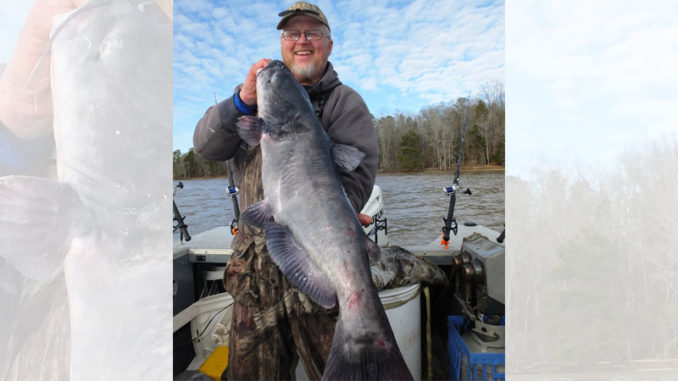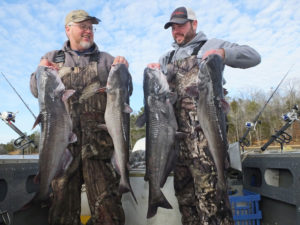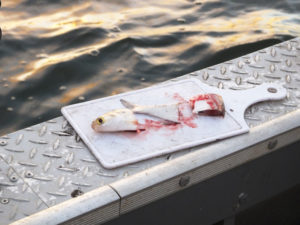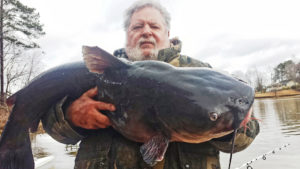
Cold weather brings out the best in this South Carolina lake’s blue catfish population. Here’s how to do some real catfish catching.
South Carolina’s Lake Wateree is a prime, winter catfish destination that provides the best of both worlds in terms of consistent action on feisty, fat catfish, as well as a realistic option for hooking heavyweight toads. The lake is teeming with 10- to 20-pound blue catfish that feed heavily in January and February, but the potential to hook fish in the 30- to 50-pound class, and even larger, is realistic on any given day.
Experienced Wateree fishermen have developed multiple ways to figuratively skin the big cats. Two with an excellent handle on the process are tournament anglers Jeff Manning and Michael Paciocco from Gastonia, N.C.
“The catfish bite is very strong at Lake Wateree during mid-winter, and fishing a tournament at that time of the year, I expect three fish weighing somewhere between 80 to 100 pounds is needed for a chance to win,” Manning said. “The tournament record at Lake Wateree was set a few years back: three fish just under 130 pounds. That’s serious ‘fat cats’ anywhere you want to fish.”
Manning said the key to fishing Lake Wateree during January is understanding that multiple patterns are potentially productive and how and when to fish each.
“Over the years, we’ve developed a solid, deep-water pattern near the main-river channel in the middle and lower end of the lake,” Manning said. “An excellent opportunity often exists far up the lake after heavy rains (when) the water has had a chance to settle. The third option occurs typically on sunny afternoons in warming trends and is a shallow-water bite.”
 The primary winter strategy for Manning and Paciosso is finding forage and targeting those spots.
The primary winter strategy for Manning and Paciosso is finding forage and targeting those spots.
“A major reason I like Wateree at this time of the year is finding where the fish are congregated,” Manning said. “That plays right into the way I prefer to fish. When the water temperatures approaches the low point of the year in January, the forage will cluster into specific areas. After years of using graphs on Lake Wateree, I think 90 percent of the forage, specifically threadfin and gizzard shad, are in perhaps 10 percent of the water. During summer the forage situation is reversed, with maybe 90 percent of the forage scattered throughout 90 percent of the water, and catfish are much more scattered. But now, the vast majority of forage is in very specific areas, relating to deep water.”
Paciocco said forage concentrated in specific deep spots, generally near the main-river channel, creates a formula for success.
“We’ll fish any technique to be successful, but our preferred method is to fish from an anchored position,” he said. “January at Wateree is absolutely ideal most of the time for what we prefer to do.”
Paciocco and Manning use electronics to hunt for concentrations of forage and then refine the search to a specific target.
“We like to pinpoint the target where we want to present bait and then anchor and cast to it,” Paciocco said. “Underwater humps, points, channel bends and deep holes are potential targets. We prefer places with big rocks or even stumps scattered on the bottom. Patterning forage and fish is a dynamic situation, with weather, water temperature and current all playing a role. But the reliable factor is, these fat blue catfish are going to be eating wherever the forage is located.”

Manning said that while they prefer to anchor fish, they’ll drift fish if that’s the best option.
“At times, the best technique will be drifting, because fish and forage may be scattered a bit too much for anchor fishing,” Manning said. “So we’ll drift the typical Santee drift rig and target areas marked with forage and fish. They’re the same type places where we like to anchor, but we simply need to present the bait by drift-fishing to cover adequate areas. At this time of year, we’ll usually drift in the 0.4 to 0.6 miles per hour range.”
Manning said another excellent pattern is to fish far uplake, especially if heavy rains have created a situation where there’s a lot of current in the upper end.
“For years, this was my favored technique, and I’ve found that it’s best after the rain has passed and the water has settled a bit,” he said. “I still graph the areas, but in the upper end of the lake, it’s obvious where some of the bluffs are located for fishing deep holes.”
A final winter option may surprise some anglers, but a strong shallow-water pattern will sometimes be present.
After two or three days of warmer temperatures, Paciocco said a bright, sunny afternoon can pull forage and big catfish back into shallow coves, with 3 to 6 feet of water being plenty deep enough.
“And it’s a great option for a big fish, too,” he said. “If we’re fishing a tournament and need an upgrade in size, when weather conditions are right, this is a very good option. It’s not a last-ditch effort; it’s a reasonable method to try to put a 30- to 40-pound fish or two in the boat.”
Manning said the three main ingredients to a successful Lake Wateree catfish-catching recipe are patience, patience and patience.
“These catfish eat during cold weather, but not non-stop,” he said. “Even if on a good spot, we have to be patient. I’ve got lots of examples of patience working, but during one tournament, we had 6 pounds at 12:30 p.m. , but shortly after 1 o’clock, we had three fish weighing 101 pounds. Another example is after fishing six hours, we had zero, then two hours later we weighed in nearly 90 pounds with three fish.”
Manning said it’s often a process of elimination.
“Most days in January and February are filled with catching lots of ‘teener-sized’ fish with larger fish sprinkled in, so the action is usually consistent,” Manning said. “But when searching for those big toads, I’ve learned to fish forage-rich targets and just be patient.”
Plenty of forage spurs Wateree cats

Robert Stroud, a fisheries biologist for the S.C. Department of Natural Resources, said he believes the blue catfish population on Lake Wateree is healthy.
“Our most-recent studies show that the blue catfish are still in an expansion phase at Lake Wateree, and the lake has a good number of 30- to 50-pound fish, as well as plenty in smaller size classes,” Stroud said. “We’ll likely see even more top-end fish but for a lake this size; the blue catfish presents a great opportunity for quality and quantity of fish.”
Stroud said a prime forage base for Wateree catfish includes both gizzard and threadfin shad.
“In addition to shad, I know the blue catfish also forage on white perch, and I’m very hopeful they continue to utilize white perch as a forage source,” he said. “Lake Wateree has a very high population of white perch, a non-native species.”
Stroud said that white perch have created issues for some species, most notably white bass. Catfish utilizing white perch is good for the lake.
“At this point the blue catfish offer anglers an excellent fishing opportunity at Lake Wateree,” Stroud said.
Veteran angler Michael Paciocco said utilizing these prime food sources for big blues during winter is a key to success.
“Without a doubt, our primary baits for wintertime blues at Wateree are shad and white perch,” Paciocco said. “These natural baits are key, and we utilize all sizes, from small to huge, and species and size can make a difference in productivity.
“White perch presentations for bait include whole live perch, perch heads, chunks of cut bait, filleted strips of perch and perch cut from the bone on both side and hooked to present maximum scent. We’ll use big gizzard shad in multiple ways as well.”
Paciocco said most of the time, big baits will produce big fish at Wateree, but they always have some smaller baits out.
“We never know what they’ll prefer on a given day, so we give them options, then refine the bait presentation based on results,” he said.
Destination Information
HOW TO GET THERE — Lake Wateree is in Kershaw, Fairfield and Lancaster counties east of I-77. Access from the south is via SC 97 to the east side of the lake. From I-77, take SSR 41 at Exit 41 to SSR 101 (River Road). From Camden, take US 521 to SSR 97. For a list public boat ramps, visit www2.dnr.sc.gov/ManagedLands/BoatRamp/BoatRampSelected/1238232
WHEN TO GO — Mid-winter is prime for fat cats with much of the action in deep water. However on warm, sunny afternoons a strong shallow water bite can often be found in depths as shallow as three feet of water.
BEST TECHNIQUES — Best techniques are to fish deep-water ledges near the Catawba River channel using white perch and gizzard or threadfin shad as bait.
FISHING INFO/GUIDES — Justin Whiteside, 803-417-0070; Scott Peavy, 803-569-7017; Colonels Creek Market, 803-337-2100. See also Guides & Charters in Classifieds.
ACCOMMODATIONS — Kershaw County Chamber of Commerce, Camden, 800-968-4037; Lake Wateree State Park (camping), 803-482-6401.
MAPS — Fishing Hotspots Maps, 800-338-5957; Kingfisher Maps 800-326-0257, www.kfmaps.com; DeLorme’s South Carolina Atlas and Gazetteer, 207-846-7000, www.delorme.com.




